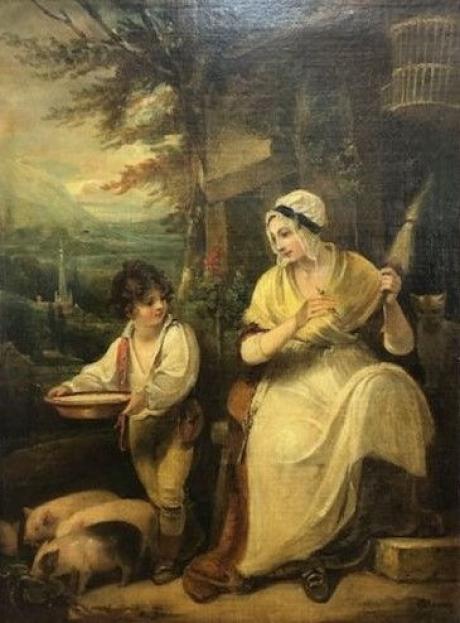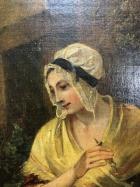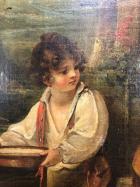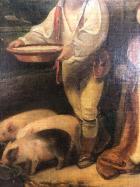A woman in simple clothes, sitting outside a cottage, left foot raised on the front step, spooling thread, looking to the left at a young boy who passes holding a shallow platter, accompanied by three piglets, landscape with a church spire in the background.
Christies Stencil number : "71KY" Sold by Vicars Brothers Ltd’ of Old Bond Street , Christies sale , 11 November 1955, lot 90, purchased by Collins incorrectly catalogued as Westall
Royal Academy 1803
Engraved, 1803, Charles Turner (1774-1857) color mezzotint and etching
This painting depicts a scene in front of an inn door. The seated woman is spinning wool while she is supervising her son who is feeding their pigs. The figures are shown in late eighteenth-century dress, which would have been considered slightly old-fashioned at the time of painting this picture. This emphasises the sentimental tone of the picture. Genre scenes of this type are influenced by the style of artists such as George Morland (1763–1804) and Francis Wheatley (1747–1801). The quality and style of the painting indicates that it was made for reproduction. This painting was reproduced as an engraving Engraved coloured mezzotint and etching in 1803, Charles Turner (1774-1857) it was widley circulated and the print is housed in many museum collections.
Genre painting developed particularly in Holland in the seventeenth century. The most typical subjects were scenes of peasant life or drinking in taverns, and tended to be small in scale. In Britain William Hogarth’s modern moral subjects were a special kind of genre, in their frankness and often biting social satire.
Simpler genre painting emerged in later eighteenth century in for example George Morland, Henry Robert Morland and Francis Wheatley. Genre painting became hugely popular in the Victorian age following the success of the brilliantly skilled but deeply sentimental works of Sir David Wilkie.
Confusingly, the word ‘genre’ is also used in art to describe the different types, or broad subjects, of painting. In the seventeenth century five types – or ‘genres’ – of painting were established, these were: history painting; portrait painting; landscape painting; genre painting (scenes of everyday life) and still life. These genres were seen by the art establishment as having varying levels of importance, with history painting (the painting of scenes from history, the bible or literature) as the most important genre, and still life (paintings of still objects) as the least important.
The new school of painting of everyday life that emerged to great acclaim in Britain during the period spanning the Napoleonic Wars and the Great Reform Bill. Initiated by David Wilkie's 'Village Politicians' of 1806, and reaching a monumenlal summation almost twenty-five years later in the work of Benjamin Robert Haydon, this movement registered the deeply ambivalent feelings of a nation in the throes of accelerating economic growth and of conflict both at home and abroad: what emerges from the imagery of its most ambitious artists is a widespread sense that the traditional boundaries between country and city are in the process of dissolving, and that a more regularised present is everywhere encroaching upon the customary past. In its fascination with the compression of space and time, early nineteenth-century British genre painting locates itself at the start of a trajectory linking the art of the Age of Revolution with the postmodern culture of the present day.
Henry Singleton (19 October 1766 – 15 September 1839) was an English painter and miniaturist.
Henry Singleton was born in London, England, into an artistic family. He was not yet two years old when his father died, so he was raised by his uncle William Singleton (d. 1793), who had studied under the tutelage of Ozias Humphry and painted portraits and miniatures. Another uncle, Joseph Singleton, exhibited at the Royal Academy between 1773 and 1788. He was working as a professional artist by the age of 16. He entered the Royal Academy Schools in 1783 and exhibited at the Royal Academy from 1784 until his death. Henry’s sisters Maria and Sarah (later Macklarinan) were miniaturists who exhibited at the Royal Academy from 1808 to 1820 and from 1787 to 1806 respectively. In 1807 Henry married his cousin William Singleton’s only daughter.
Although Singleton, like his uncles and sister, also painted miniatures, he did not adhere strictly to the genre. He exhibited at the Royal Academy, between 1784 and 1839, approximately 300 works, a large proportion of which were portraits, with scriptural subjects making up much of the remainder. He was for many years the Royal Academy's oldest living exhibitor. His works were also exhibited at the British Institution from 1806 and at the Society of British Artists from 1824 until his death in 1839. From the age of sixteen, Singleton worked as a professional portraitist. He attended the Royal Academy Schools from the age of seventeen and won the silver medal in 1784. His painting from John Dryden’s ode Alexander’s Feast won the gold medal in 1788. In 1793, Singleton was commissioned by the Royal Academy to paint a group portrait of forty of the academicians. Ironically, he never became a member or an associate of the Academy himself. Early in his career, Singleton was noted for large compositions from the Bible, Shakespeare or contemporary historical events. Although his portrait work was always in demand, he never achieved the great success as a historical painter that his early promise indicated. Lord Nelson, Admiral Vernon, Lord Howe and John "Mad Jack" Fuller are among his portrait sitters. Paul I Granting Liberty to Kościuszko (1797) and The Death of Captain Alexander Hood after Capturing the French 74 "L'Hercule", 21 April 1798 are considered by some to be his best works. Shortly before his death, Singleton completed a series of cabinet pictures to illustrate the works of Shakespeare.
Henry Singleton’s works are currently in the collections of the British Museum, the Victoria and Albert Museum, the National Portrait Gallery (London), the Scottish National Portrait Gallery, Tate Britain, the Ulster Museum, the Royal Institution and the Brighton Art Gallery.Henry Singleton was a portrait painter and book-illustrator best known today for his imposing ceremonial groups, such as his ‘Marriage of the Duke of York’ of 1791 (Minneapolis Institute of Art) and ‘ Royal Academicians in Council’ of 1793 (Royal Academy). This sketch of the marriage of the Prince of Wales was perhaps intended for presentation, possibly to seek a speculative commission for a larger painting.
Many of Singleton’s work represent historical or contemporary events, such as Paul I Granting Liberty to Kosciuszko (1797) and The Death of Captain Alexander Hood after Capturing the French 74 ‘L'Hercule’, 21 April 1798. Many of these were engraved in mezzotint and consequently became popular.
Another large group of Singleton’s works are based on mythological, biblical and Shakespearian themes, for example Manto and Tiresias (exhibited 1792, Tate Britain) and Ariel on a Bat’s Back (exhibited 1819, Tate Britain). He also painted some portraits, for example of the writer James Boswell (1740-1795) (c. 1795; Edinburgh, National Portrait Gallery). Singleton has never fully developed his potential as a history painter. His later works, smaller in scale and less confident in the depiction of figures, can be described as sentimental. He produced many book illustrations, and was one of the first English lithographers.
This painting depicts a scene in front of an inn door. The seated woman is spinning wool while she is supervising her son who is feeding their pigs. The figures are shown in late eighteenth-century dress, which would have been considered slightly old-fashioned at the time of painting this picture. This emphasises the sentimental tone of the picture. Genre scenes of this type are influenced by the style of artists such as George Morland (1763–1804) and Francis Wheatley (1747–1801). The quality and style of the painting indicates that it was made for reproduction. This painting was reproduced as an engraving Engraved coloured mezzotint and etching in 1803, Charles Turner (1774-1857) it was widley circulated and the print is housed in many museum collections.
Singleton turned into producing images for engraving late in his career. Although he had never achieved the status of a respected history painter, he was nevertheless very successful and popular through his prints and book illustrations. Cooperation with engravers was an effective and profitable method of answering the growing demand for him images.
The portrait and history painter Henry Singleton painted one of the most important group portraits of the early Royal Academicians. In 1793 Singleton received an important commission to paint a large portrait group of The Royal Academicians in General Assembly (1795), which shows the Academicians in the Council Room at Somerset House. Charles Bestland, a printmaker and dealer who published a print of this picture probably commissioned the work. Despite painting this important group portrait, Singleton never became an Academician himself. He was twice rejected for Associateship, in 1807 and 1811.
Singleton first rose to prominence as a history painter. He never fulfilled his potential in this genre but remained popular throughout his life, particularly as a portrait painter. He lived in comfortable circumstances in London and died at the house of a friend in 1839 at the age of 72, at the house of a friend at 7 Kensington Gore, and was buried in the church of St Martin-in-the-Fields.
References
Foster, J. J. (Joshua James) (June 1967). A Dictionary of Painters of Miniatures (1525–1850): with some account of exhibitions, collections, sales, etc., pertaining to them (1926). Lenox Hill Publishing (Jun 1967). ISBN 0-8337-1218-7.
Harrington, Peter (1993). British Artists and War: The Face of Battle in Paintings and Prints, 1700–1914. Greenhill (1993). ISBN 1-85367-157-6.
Matthew, H. C. G. (Henry Colin Gray). Oxford Dictionary of National Biography: in association with the British Academy: from the earliest times to the year 2000. Oxford University Press, 2004. ISBN 0-19-861411-X.




